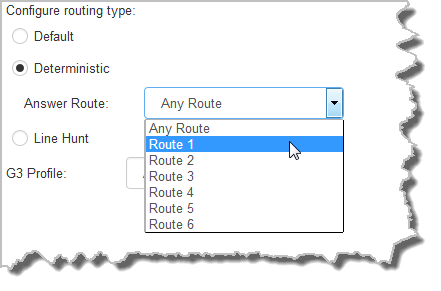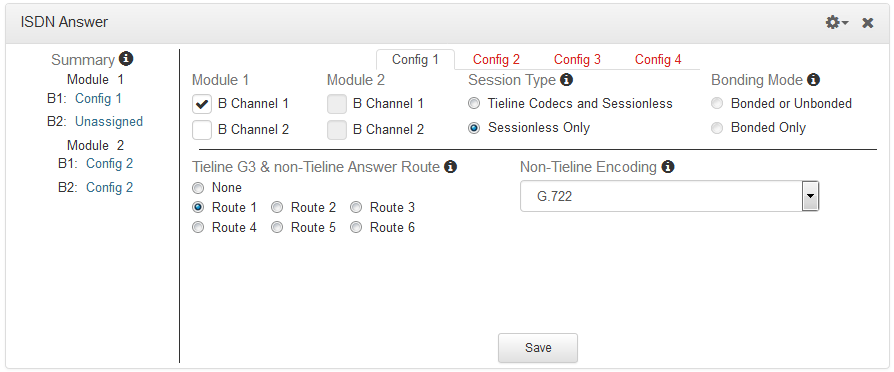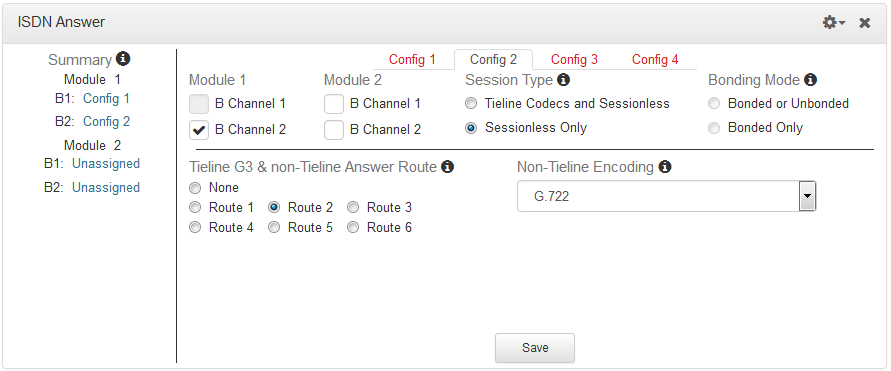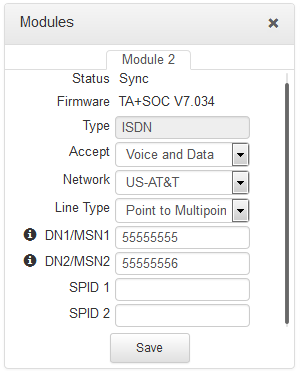
Tieline Genie Distribution, Merlin, Merlin PLUS and ViA audio codecs support multiple connections using a variety of connection transports such as IP, ISDN and POTS. Tieline codecs support using Tieline session data, which assists with configuration and routing of multiple incoming calls to these codecs. In addition, audio ports can be used to successfully route IP calls to your preferred codec inputs/outputs.
If you are accepting calls from multiple non-Tieline ISDN codecs then you will be making "sessionless" connections which require the codecs at both ends to be configured with the same connection settings. In addition you can use “Answer Routes” and 'site-specific' module settings in Genie Distribution and Merlin PLUS to route incoming calls to specific codec outputs. (Note: Merlin codecs can also be configured to accept 2 ISDN calls from non-Tieline codecs and would use similar settings).
In the following example we will configure two incoming sessionless ISDN audio stream connections (Note: Genie Distribution and Merlin PLUS support up to 4 sessionless ISDN audio streams/connections/configs using 2 ISDN modules and 4 B channels). If you want 2 incoming mono ISDN calls to use inputs/outputs 1 and 2, then use answering audio stream connections 1 and 2 in a 2 x mono peer-to-peer program.
So let's get started. There are 2 or 3 steps to ensure this is configured correctly, depending on whether you want specific incoming calls to always use the same B channels and codec outputs or not.
Step 1: Configure the Answer Route for the two ISDN Audio Stream answering connections in the codec program.
Setup two ISDN audio stream answering connections in your program and use the Answer Route setting in the program wizard (as displayed in the following image):

You can use any Answer Route, for example Route 1 for ISDN Audio Stream 1 and Route 2 for ISDN Audio Stream 2. The Answer Route number doesn’t have to match the audio stream number because the route you select will be used by the incoming ISDN call. This is similar to how an “extension number” is used to route a phone call.
Step 2: Configure the ISDN Module to accept two sessionless ISDN calls.
This can be configured via Settings > Modules or use the Toolbox Web-GUI via Transport > ISDN Answer Modules.
1.Select Config 1 and Sessionless Only and Route 1. Select your preferred algorithm, then click Save. This means that Module 1 B channel 1 will answer a sessionless ISDN call using these settings.

2.Next select Config 2 and Sessionless Only and Route 2. Select your preferred algorithm, then click Save. This means that Module 1 B channel 2 will answer a sessionless ISDN call using these settings.

Both ISDN B channels can now answer incoming sessionless ISDN calls. If it doesn’t matter which incoming codec call is answered by which B channel then that’s all you need to do. If, however, you want each non-Tieline codec to use the same B channel and be routed to the same codec output consistently, you must configure this in the site config for the ISDN module via Settings > Answering > ISDN Answer Configs, or via the Web-GUI using the Settings panel > Modules.
Step 3: Configuring the module to answer calls from a specific non-Tieline codec consistently.
If a Directory Number (DN) or MSN number is not entered in the codec and multiple B channels are available, the codec may use any channel to answer an incoming call. To ensure calls are routed consistently, enter a DN/MSN number (without the country or area code) as the DN/MSN for a B channel, then only that corresponding B channel will answer an incoming call to that number.
Enter the number for the first B channel into the field for Directory Number/MSN1. (This has been allocated Route 1 previously.) Enter the number for the second B channel into the field for Directory Number/MSN2. (This has been allocated Route 2 previously.) Next, click Save.

If codec 1 always uses the first directory number to call then it will always be routed via Route 1 to the Answering Audio Stream Connection using Answer Route 1 (configured in step 1). Codec 2 should always use the second directory number and then it will always be routed via Route 2 to the Answering Audio Stream Connection configured with Answer Route 2.
